Digger Farm
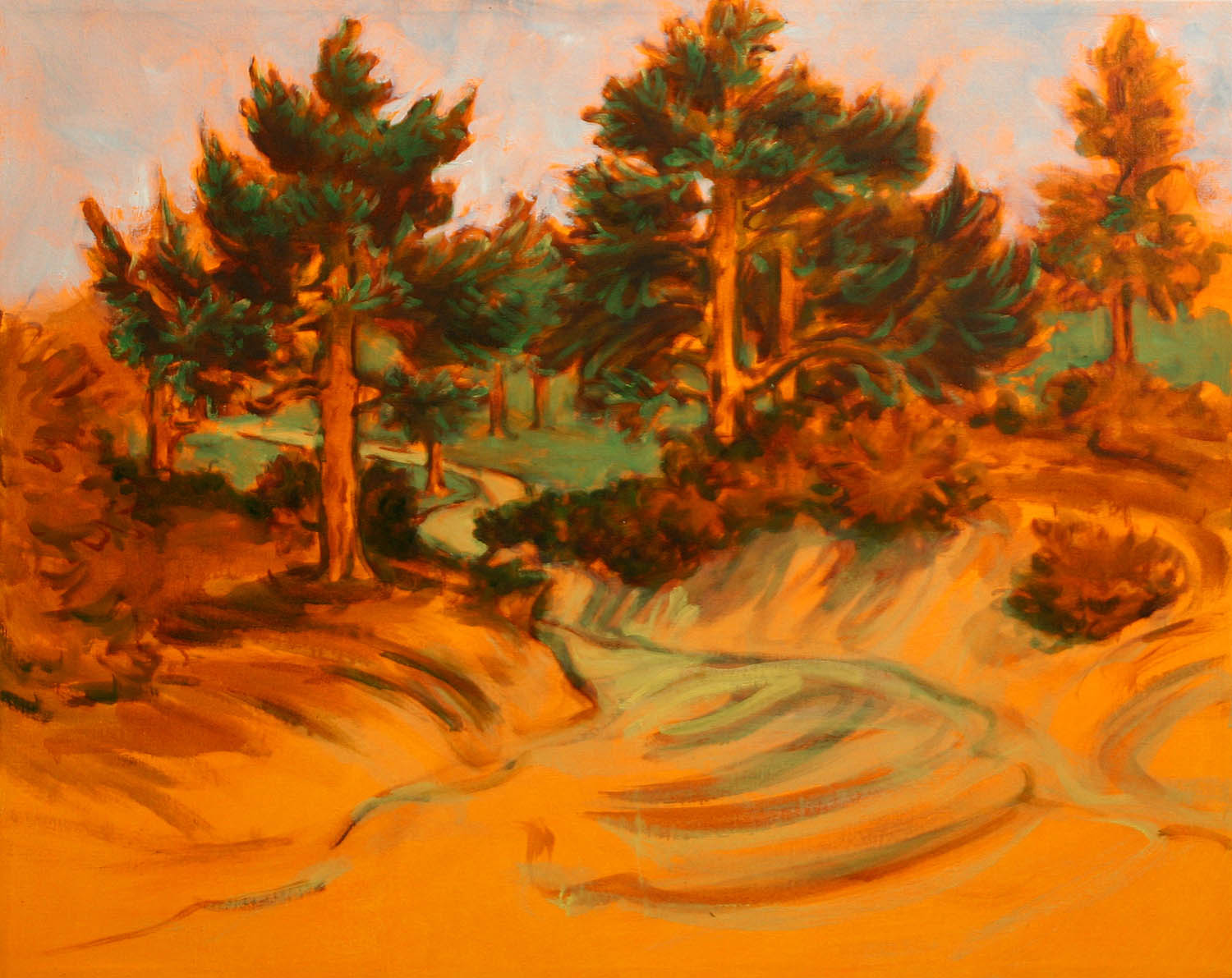
Sigrid Holmwood
Path from St George’s Hill
Fluorescent orange yellow egg/oil emulsion; burnt siena, lead antimonate, verdigris, smalt, lead white, shiet gel in oils on canvas, 92 × 93 cm, 2009
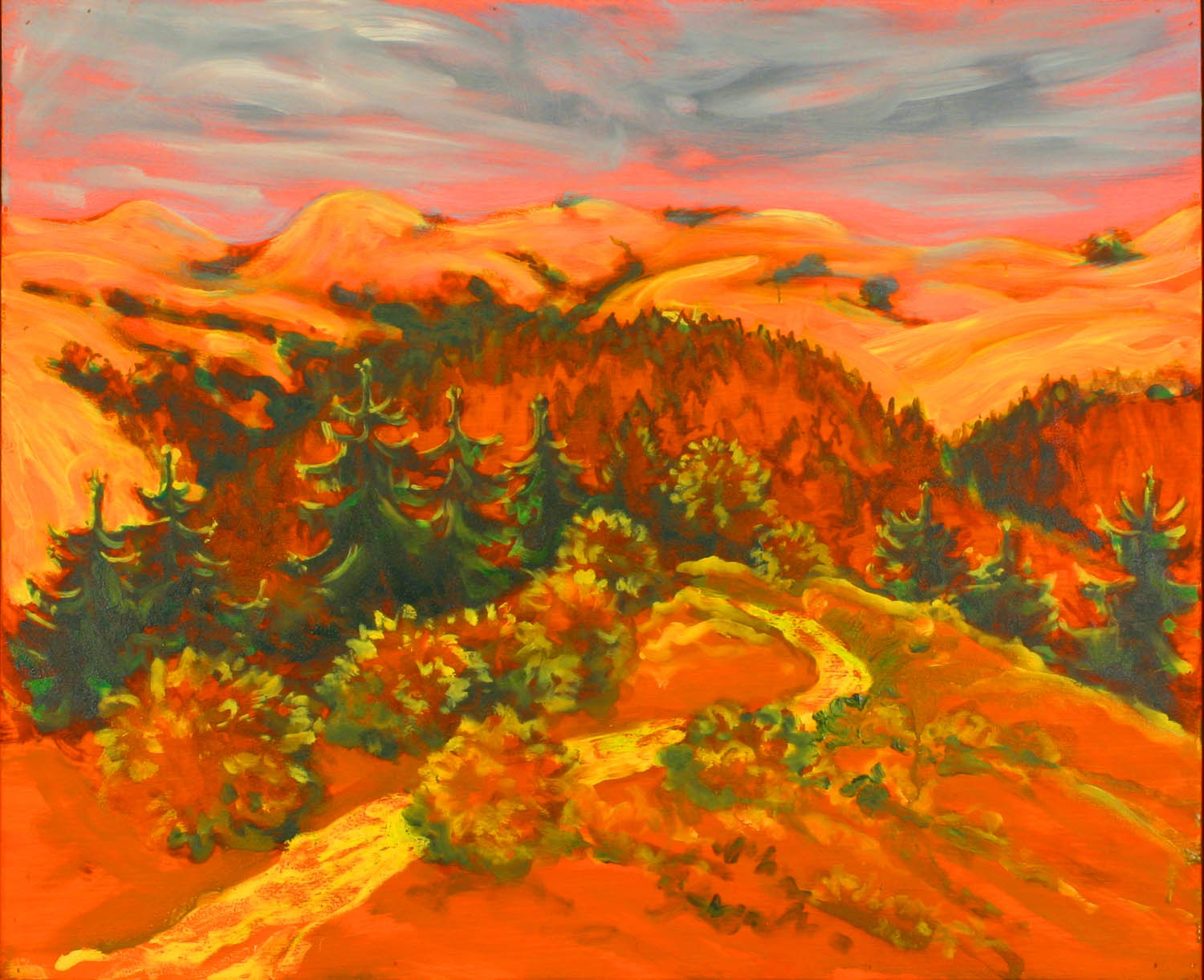
Sigrid Holmwood
Wheeler’s Land/Open Land
Fluorescent orange egg/oil emulsion; burnt siena, lead antimonate, green earth, verdigris, lead white, bone black in oils on board, 61 × 50 cm, 2009
These paintings came out of a research trip to Sonoma County, California, exploring the links between the 17th century English Diggers, and the 1960’s hippies that set up an Open Land communes, Morningstar and Wheeler’s, also dubbed Digger Farm.
The English Diggers, disappointed with outcomes of the English Civil War, which only extended rights to land owners, set up a commune on common land on St George’s Hill, Surrey, proclaiming that ‘God’s Treasury should be shared by all’. In 1975 a film (Winstanley) about the English Diggers and their leader, Gerard Winstanley, was made by Kevin Browlow and Andrew Mollo, using amateur actors, civil war re-enactors and anarchist hippies, including Sid Rawle.
The Sonoma hippies took the story of the English Diggers as inspiration for their Free Land movement. I met with some of the old hippies who shared their photos, stories and memories, and visited the sites of the former communes, where I found the remains of camps and structures. More information about the Californian diggers and the communes at Morningstar and Wheeler’s can be found in their web archive (http://www.diggers.org/most/morningstar.htm ).
(Sigrid Holmwood)
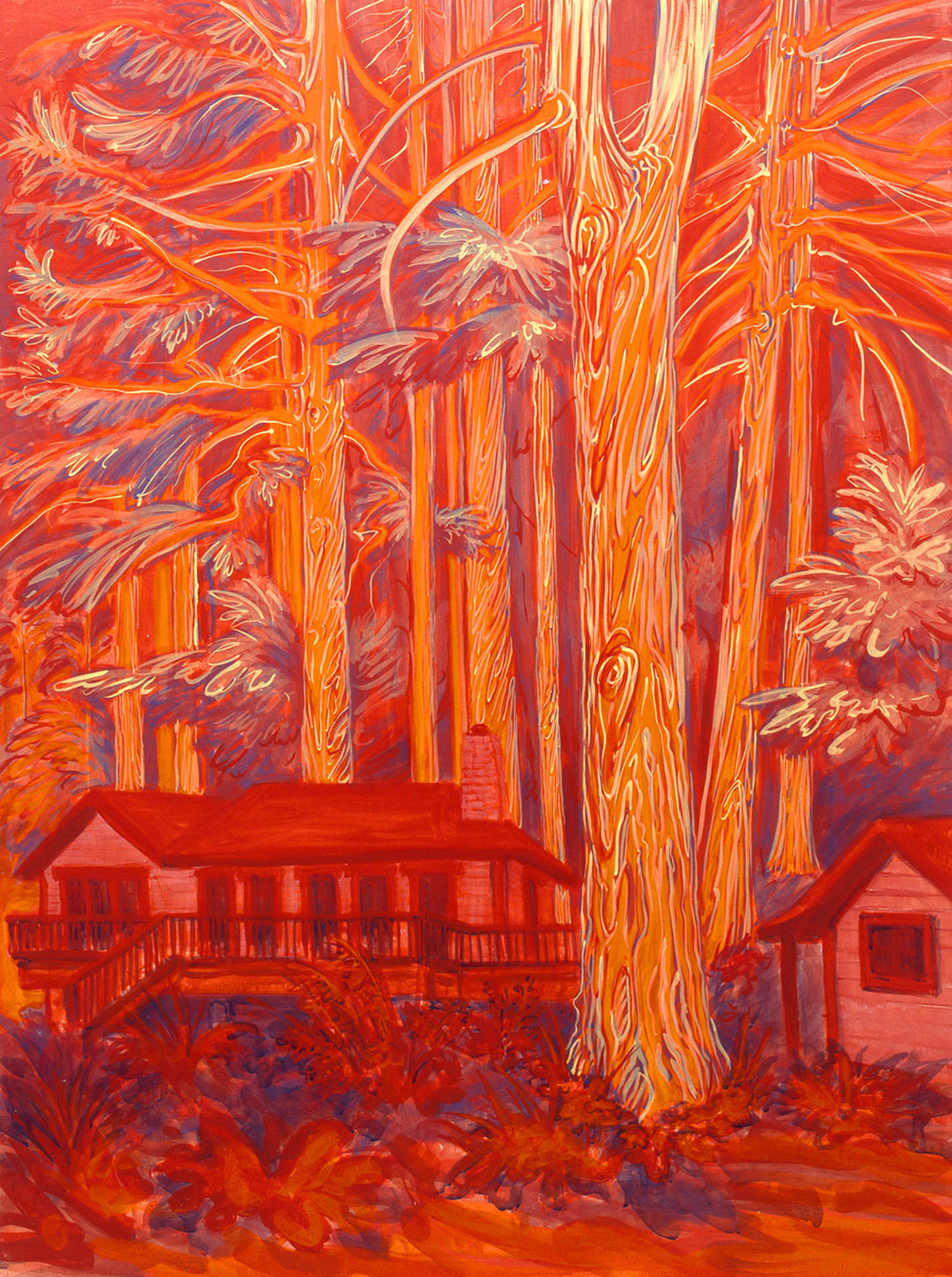
Sigrid Holmwood
Ken Kesey’s Ranch at La Honda
Fluorescent orange, lead tin yellow, ultramarine ashes and vermillion in egg tempera on board, 122 × 90 cm, 2008
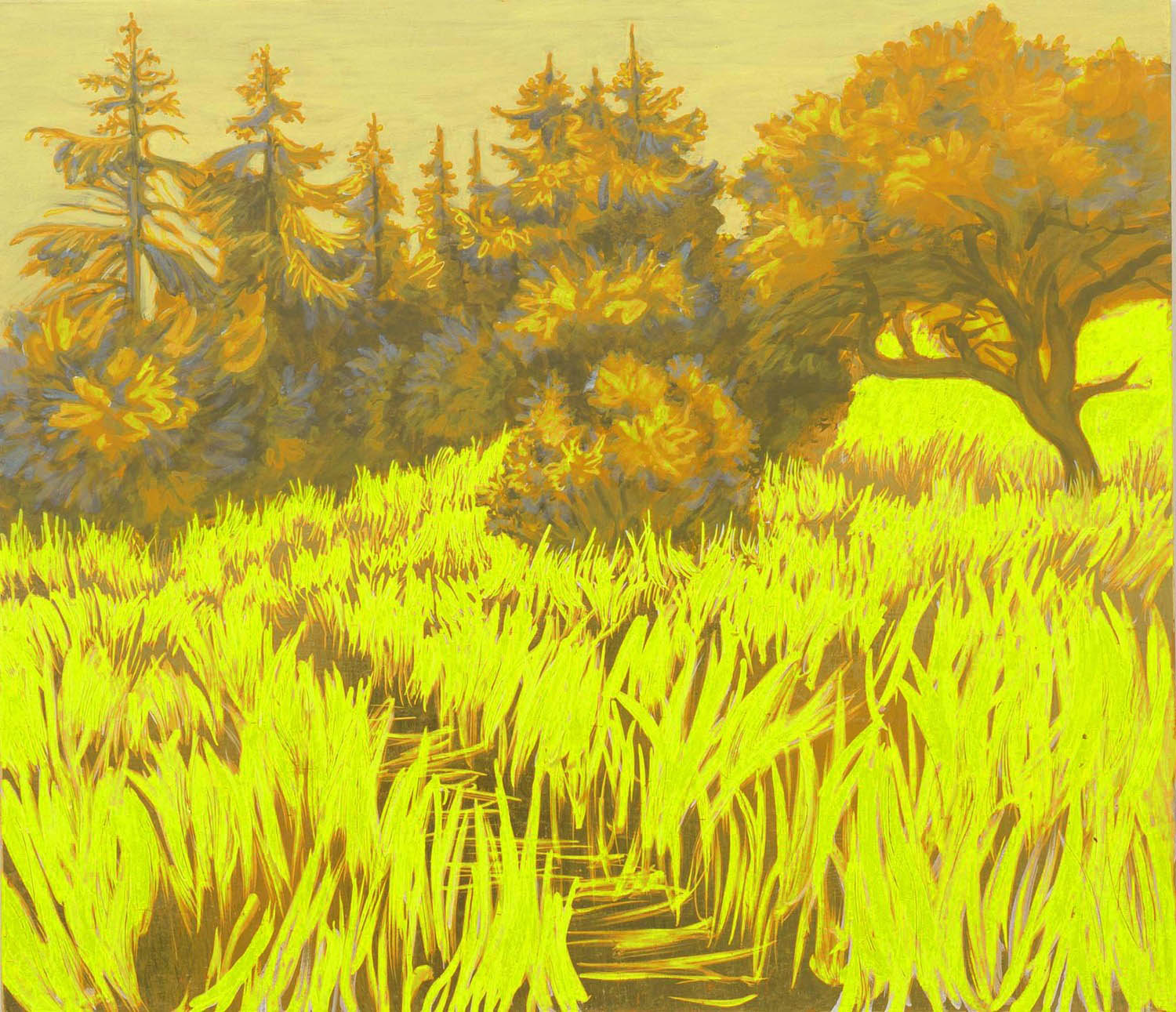
Sigrid Holmwood
Lower meadow at Morningstar
Gold leaf, fluorescent yellow, yellow ochre, lead tin yellow, burnt umber and ultramarine ashes in egg tempera on board, 60 × 70 cm, 2008

Sigrid Holmwood
Hippie artist
Gold leaf, fluorescent golden yellow, lead tin yellow, green earth, plods blue, verditer, zinc white and yellow ochre in egg tempera on board, 90 × 60 cm, 2008
"Digger" is defined as a British agricultural movement in the interpretation of the Encyclopaedia Britannica. In 1649–50, the movement was led by a group of agrarian communists, Gerrard Winstanley and William Everard. In April 1649, about 20 poor people gathered in St. George’s Hill, Surrey, to start farming in this common land. These diggers believed that the British Civil War was started out against the king and the "great" landowners. Since Charles I has been executed, the poor should be provided with land for cultivation. Food prices reached a record high in the late 1640s, and the number of diggers more than doubled in 1649. Their activities shocked the Commonwealth government and provoked hostility among local landowners. By the end of March 1650, they were dispersed from the common land where they farmed.
Winstanley
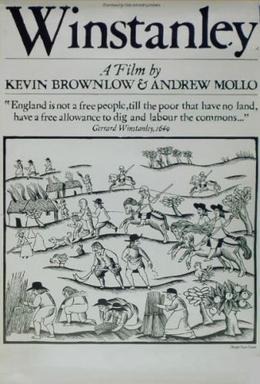
This is a poster for Winstanley. The poster art copyright is believed to belong to BFI Production.
With the support of the BFI Produstion Board, Winstanley was co-produced and co-directed by Kevin Brownlow and historical consultant Andrew Mollo, based on David Caute's novel Comrade Jacob. Known as a film historian, Kevin Brownlow brought historians' passion for authenticity and detail to the production of Winstanley.
This 1975 black-and-white film tells the story of the 17th century social revolutionary and writer Gerrard Winstanley, who, along with a small group of followers, known as the "Diggers", tried to establish a self-sufficient agricultural community "Diggers' Hill" on the common land in St. George's Hill, one of the world's first small experiments in socialism or communism, whose ideas was disseminated to other parts of England during Oliver Cromwell’s Protectorate period, but it was quickly suppressed, leaving only the source of ideas that inspired future generations of socialist theorists.
The San Francisco Diggers is one of the legendary groups in the Haight-Ashbury area of San Francisco. The Haight-Ashbury area was one of the birthplaces of the counter-mainstream culture of the 1960s. Since then, the United States and world culture have changed. The group of diggers is shrouded in anonymity, their names are taken from the British diggers (1649-50), the earliest group of diggers to promote social conceptions, such as liberating private property and various forms of buying and selling. The San Francisco Digger Group was evolved from two groups of radicals that emerged in the SF Bay Area in the mid-1960s: Bohemian / Underground Art / Theatre, and the New Left / Civil Rights / Peace Movement.
The San Francisco Diggers Group combines street theatre, Anarchism, Anarcho-direct action and art events in the social agenda of creating a "free city". Their most famous event is to revolve around the park every day, distribute "free food" inside, and distribute "remaining energy" on a series of free stores (everything is free). The San Francisco Diggers Group has also created a variety of slogans that have played a role in counter-mainstream culture and society as a whole, the most recognisable ones are "Do your own thing" and "Today is the first day of the rest of your life".

Aerial view of Morning Star Ranch. In the upper center of the photo are the Upper House and Egg Shed.
In the north of San Francisco, across the entrance to the legendary Golden Gate Bridge, the rolling hills of Marin County and Sonoma County are golden in summer and verdant in winter. Morningstar Commune was founded by Lou Gottlieb, a former member of the folk-singing trio Limeliters. It is also known as the “digger farm” in the Haight region, supplying apples and other organic fruits and vegetables for the Free food program.
The two open-air public communes of Morningstar and the Wheeler’s were unprecedented in the late 1960s. People from all over the United States gathered here to rediscover a new tribal lifestyle and consume less energy but also provide more choices for consumer-led social trends.
Some images from the web (Source: Wikipedia, The Digger Archives)
The text is edited from the website of the artist Sigrid Homewood, Wikipedia, The Digger Archives and other related websites.
Image and Text: Permagate Space, ©Authors, Permagate Space, 2019







